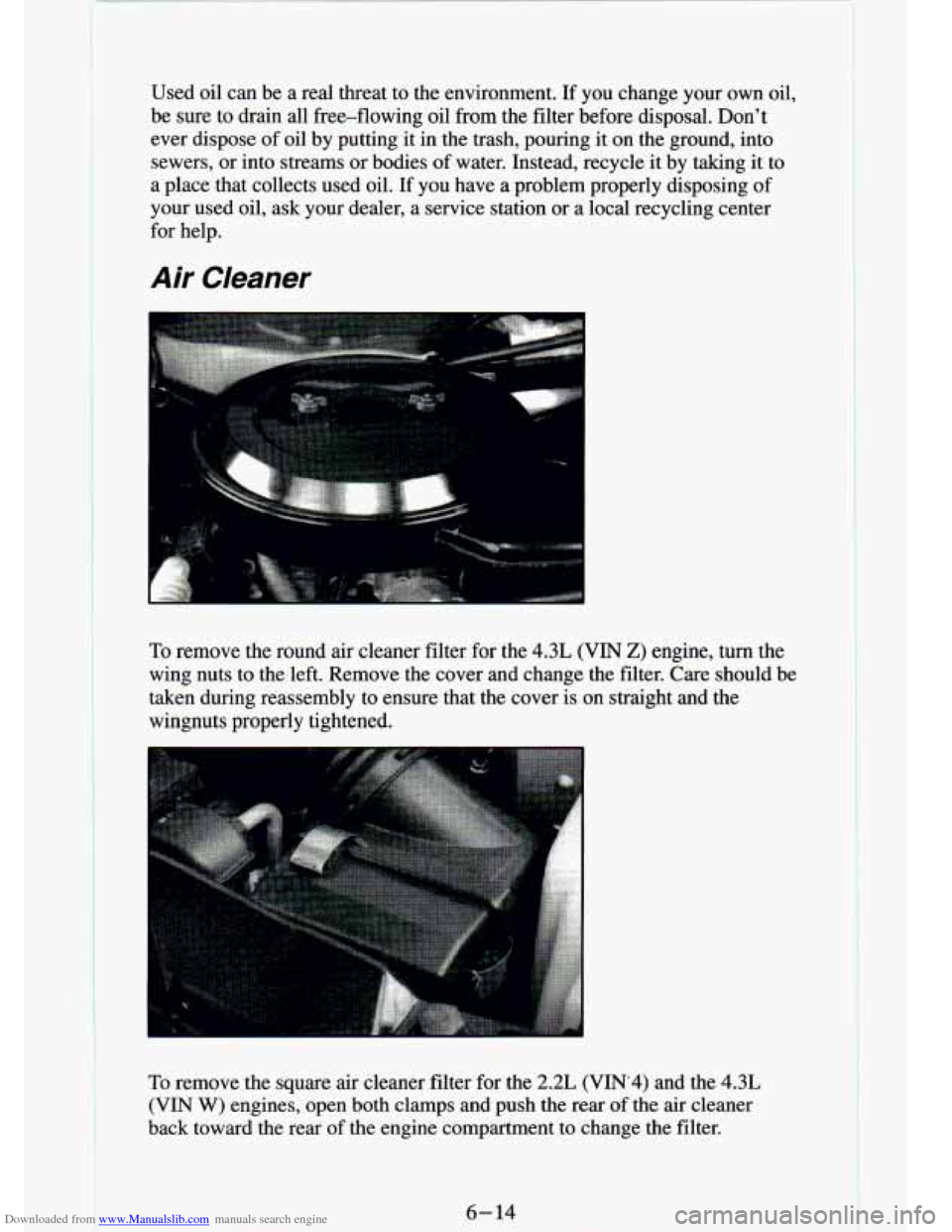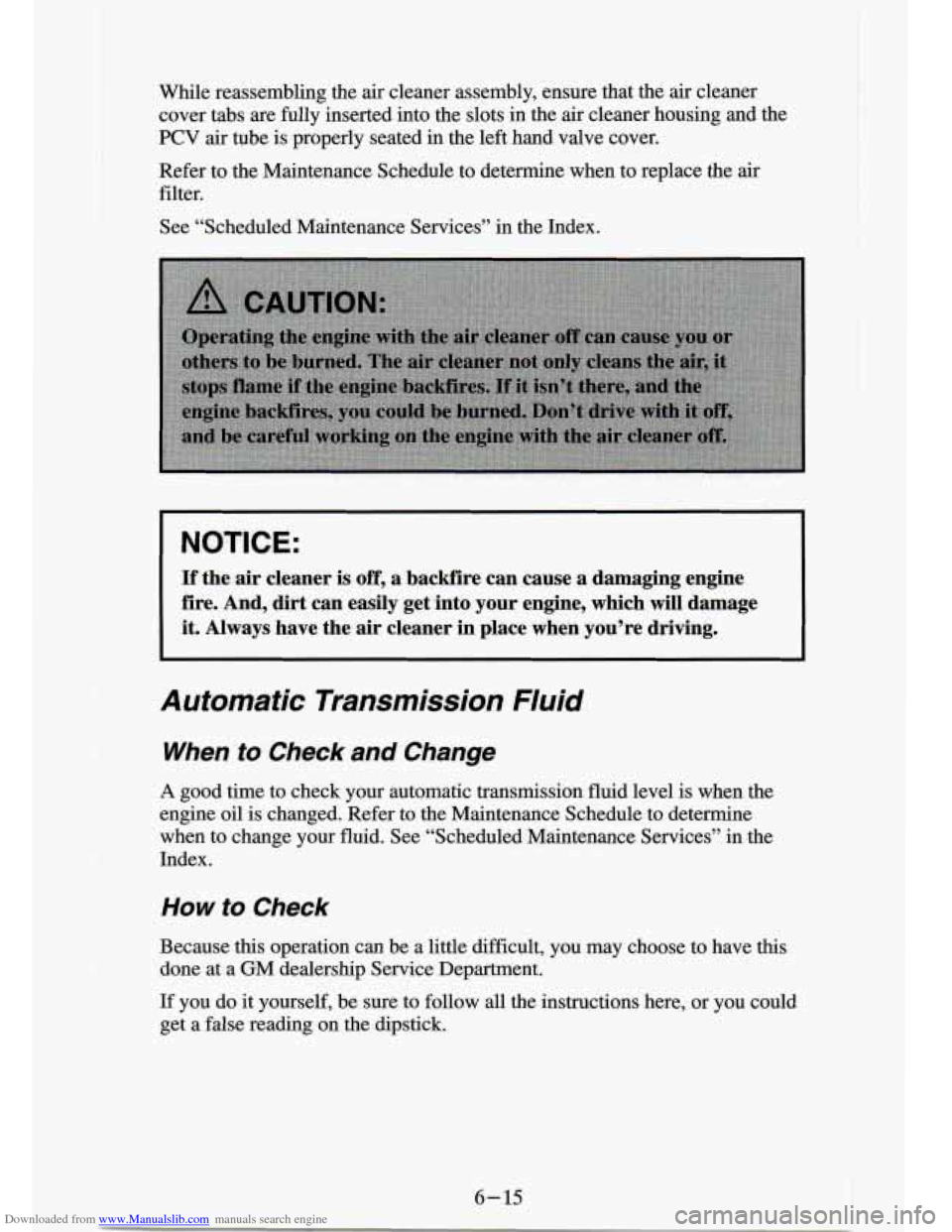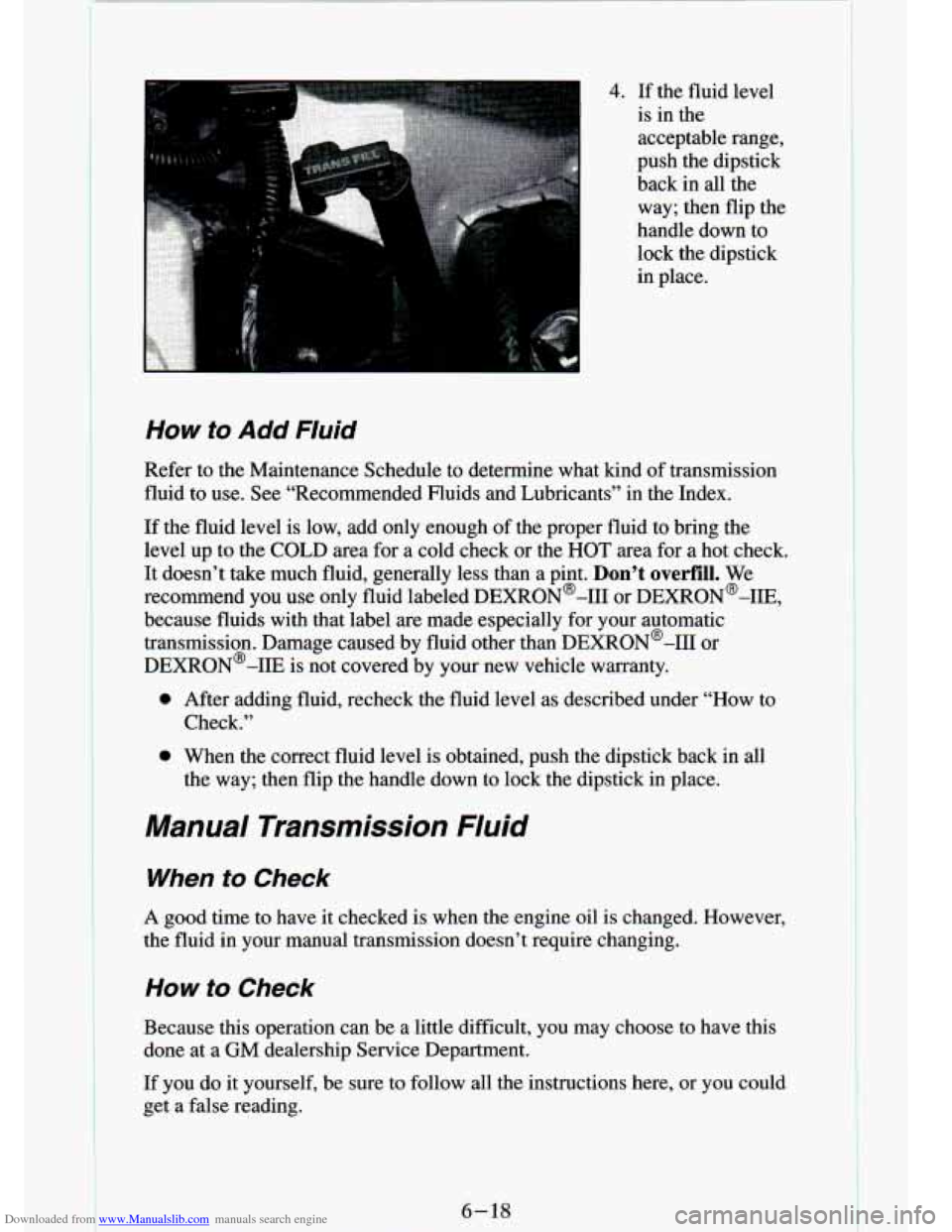Page 220 of 340
Downloaded from www.Manualslib.com manuals search engine Service
Your GM dealer knows your vehicle best and wants you to be happy with\
it.
We hope you’ll go to your dealer for all your service needs. You’ll get
genuine GM parts and GM-trained and supported service people.
We hope you’ll want to keep your GM vehicle all GM. Genuine G\
M parts
have one of~these rnarks:
Doing Your Own Service Work
If you want to do some of your own service work, you’ll want to get the
proper GM Service Manual. It tells you much more about how to service
your vehicle than this manual can.
To order the proper service manual, see
“Service Publications” in the Index.
You should keep a record with all parts receipts and list the mil\
eage and the
date
of any service work you perform. See “Maintenance Record” in \
the
Index.
6-2
Page 222 of 340

Downloaded from www.Manualslib.com manuals search engine Gasolines for Cleaner Air
Your use of gasoline with deposit control additives will help prevent
deposits from forming in your engine and fuel system. That hel\
ps keep your
engine
in tune and your emission control system working properly. It’s \
good
for your vehicle, and you’ll be doing your part for cleaner air.
Many gasolines are now blended with oxygenates. General Motc
recommends that you use gasolines with these blending niaterials,
sucn as
MTBE and ethanol. By doing so, you can help clean the air, especially in
those parts of the country that have high carbon monoxide levels.
In addition, some gasoline suppliers are now producing reformulated
gasolines. These gasolines are specially designed to reduce vehi\
cle
emissions. General Motors recommends that you use reformulated g\
asoline.
By doing
so, you can help clean the air, especially in those parts of the
country that have high ozone levels.
You should ask your service station operators
if their gasolines contain
deposit control additives and oxygenates, and if they have been\
reformulated to reduce vehicle emissions.
Fuels in Foreign Countries
If you plan on driving in another country outside the U.S. or Canada,
unleaded fuel may be hard to find. Do not use leaded gasoline. If you use
even one tankful, your emission controls won’t work well or \
at all. With
continuous use, spark plugs can get fouled, the exhaust system \
can corrode, and your engine oil can deteriorate quickly. Your vehicle’s oxygen sensor
will be damaged. All of that means costly repairs that wouldn’t be covered
by your warranty.
To check on fuel availability, ask an auto club, or contact a ma\
jor oil
company that does business in the country where you’ll be d\
riving.
You can also write us at the following address for advice.
Just tell us where.
you’re going and give your Vehicle Identification Number (VI\
N).
General Motors Overseas Distribution Corporation
North American Export Sales (NAES)
1908 Colonel Sam Drive
Oshawa, Ontario
L1H 8P7
6-4
Page 232 of 340

Downloaded from www.Manualslib.com manuals search engine Used oil can De a real threat to the environment. If you change your own oil,
be sure to drain all free-flowing oil from the filter before \
disposal. Don’t
ever dispose of oil by putting
it in the trash, pouring it on the ground, into
sewers, or into streams or bodies of water. Instead, recycle it by taking it to
a place that collects used oil. If you have a problem properly disposing of
your used oil, ask your dealer, a service station or
a local recycling center
for help.
Air Cleaner
To remove the round air cleaner filter for the 4.3L (VIN 2) engine, turn the
wing nuts to the left. Remove the cover and change the filter\
. Care should be
taken during reassembly to ensure that the cover is on straigh\
t and the
wingnuts properly tightened.
To remove the square air cleaner filter for the 2.2L (VnV.4) and the 4.3L
(VIN W) engines, open both clamps and push the rear of the air cleaner
back toward the rear of the engine compartment to change the filter.
Page 233 of 340

Downloaded from www.Manualslib.com manuals search engine While reassembling the air cleaner assembly, ensure that the air cleaner
cover tabs
are fully inserted into the slots in the air cleaner housing and the
PCV air tube is properly seated in the left hand valve cover.
Refer to
the Maintenance Schedule to determine when to replace the air
filter.
See “Scheduled Maintenance Services”
in the Index.
NOTICE:
If’ the air cleaner is off, a backfire can cause a damaging engine
fire.
And, dirt can easily get into your engine, which will damage
it. Always have the
air cleaner in place when you’re driving.
Automatic Transmission Fluid
When to Check and Change
A good time to check your automatic transmission fluid level is when the
engine oil is changed. Refer to the Maintenance Schedule to determine
when to change your fluid. See “Scheduled Maintenance Services” in the
Index.
How to Check
Because this operation can be a little difficult, you may choose to have this
done at a
GM dealership Service Department.
If you
do it yourself, be sure to follow all the instructions here, or you \
could
get a false reading on the dipstick.
6-15 I
Page 236 of 340

Downloaded from www.Manualslib.com manuals search engine 4. If the fluid level
is in the
acceptable range,
push the dipstick
back in all the
way; then flip the
handle down to
lock the dipstick
in place.
How to Add Fluid
Refer to the Maintenance Schedule to determine what kind of transmission
fluid to use. See “Recommended Fluids and Lubricants”
in the Index.
If the fluid level is low, add only enough of the proper fluid to bring the
level up to the COLD area for a cold check or the
HOT area for a hot check.
It doesn’t take much fluid, generally less than a pint.
Don’t overfill. We
recommend you use only fluid labeled DEXRON@-I11 or DEXRON@-IIE,
because fluids with that label are made especially for your automatic
transmission. Damage caused by fluid other than DEXRON@-I11 or
DEXR0N’-IIE is not covered by your new vehicle warranty.
0 After adding fluid, recheck the fluid level as described under “How to
Check.”
0 When the correct fluid level is obtained, push the dipstick ba\
ck in all
the way; then flip the handle down to lock the dipstick in place.
Manual Transmission Fluid
When to Check
A good time to have it checked is when the engine oil is changed. However,
the fluid in your manual transmission
doesn’t require changing.
How to Check
Because this operation can be a little difficult, you may choose to have this
done at a
GM dealership Service Department.
If you do it yourself, be sure to follow all the instructions\
here, or you could get a false reading.
6-18
Page 238 of 340
Downloaded from www.Manualslib.com manuals search engine Hydraulic Clutch
The hydraulic clutch in your vehicle is self-adjusting. A slight amount of
play
(1/4 inch to 1/2 inch) in the pedal is normal.
When to Check and What to Use
Refer to the Maintenance Schedule to determine how often you should
check the fluid level in your clutch master cylinder reservoir and what to
add. See “Owner Checks and Services” and “Recommended F\
luids and
Lubricants” in the Index.
How to check
The proper fluid should be added if the level does not reach the bottom of
the diaphragm when it’s in place in the reservoir. See the \
instructions on the
reservoir cap.
Rear Axle
When to Check and Change Lubricant
Refer to the Maintenance Schedule to determine how often to ch\
eck the
lubricant and when to change it. See “Scheduled Maintenance Services” in
the Index.
6-20 I i
Page 240 of 340
Downloaded from www.Manualslib.com manuals search engine How to Check Lubricant
6-22
I
Refer to the Maintenance Schedule to determine how often to check the
lubricant and when to change
it. See “Scheduled Maintenance Services” in
the Index.
How to Check Lubricant
If the level is below
the bottom of the filler
plug hole, you’ll need
to add some lubricant.
Add enough lubricant
to raise the level to the
bottom
of the filler
plug hole.
The arrow on the left shows the drain plug location. The arrow
on the right
shows the filler plug location.
What to Use
Refer to the Maintenance Schedule to determine what kind of lubricant to
use. See “Recommended Fluids and Lubricants” in the Index.
Front Axle
When to Check and Change Lubricant
If the level is below
the bottom of the filler
plug hole, you’ll need to add some lubricant.
Page 243 of 340
Downloaded from www.Manualslib.com manuals search engine Add coolant mix at the recovery tank, but be careful not to spill it.
Radiator Pressure Cap
I NOTICE:
Your radiator cap is a 15 psi (105 kPa) pressure-type cap and
must be tightly installed to prevent coolant loss and possible
engine damage from overheating. Be sure the arrows on the cap \
line up with the overflow tube on the radiator filler neck.
When you replace
your radiator pressure cap, a
GM cap is
recommended. See
“Service Replacement
Part and Filter
Recommendations” in
the Index.
6-25